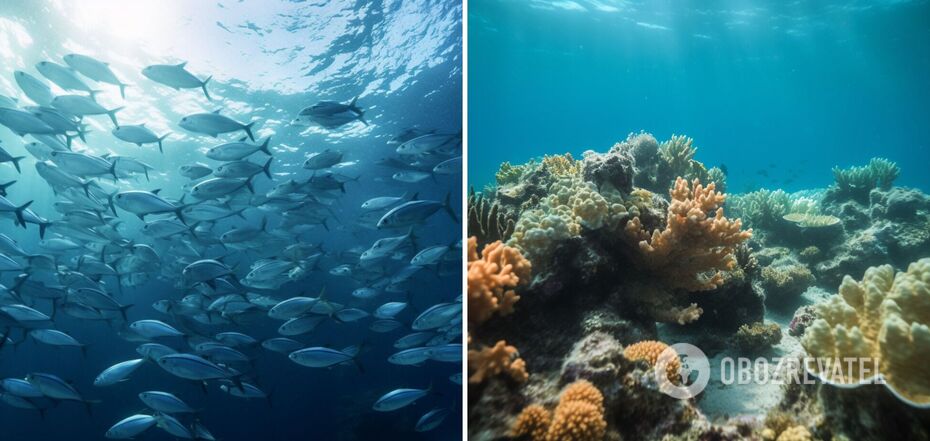Life
Global ocean temperature exceeds all known limits: what will happen next
In April this year, scientists recorded a new record for global ocean temperature. At the beginning of last month it was 21.1 degrees Celsius, which is 0.1 degrees higher than the previous record set in March 2016. And in this the researchers see an anomaly.
As Nature writes, although the record corresponds to the predicted warming of the ocean, it took place earlier than expected. Not during the El Niño climate phenomenon, which is expected to bring warmer and wetter weather to the eastern Pacific later this year. And that's the bad news.
What are the dangers of a global ocean temperature record
Recorded warming of the water means that above-average ocean temperatures are likely to persist, or even rise. This will entail extreme weather and heat waves in the seas that are damaging to marine life from corals to whales. "We are likely to have a series of record highs next year. The coming year will be turbulent if El Niño really intensifies," explained oceanographer Josh Willis of NASA's Jet Propulsion Laboratory in Pasadena, California.
What is El Niño
The El Niño Southern Oscillation (ENSO) is a natural cyclical climate pattern. During the El Niño phase, the winds over the Pacific Ocean become weaker or reverse their direction. This allows warm waters to move eastward across the Pacific Ocean. This phenomenon tends to coincide with warmer years both in the ocean and on land. For example, the previous global ocean temperature record of 21 degrees Celsius was recorded precisely during the very strong El Niño phenomenon.
Now ENYUK is in a neutral phase. This is evidenced by a rare three-year period of La Niña, a phenomenon opposite to El Niño. But scientists predict that ENYUK will return as early as this year. The World Meteorological Organization says it has a 60 percent chance of developing between May and July, and up to 80 percent by October.
What scientists are predicting for the coming months
Oceanographer Andrew Leising of the U.S. National Oceanographic and Atmospheric Administration's Southwest Fisheries Science Center expects unusually warm Pacific waters to reach the U.S. west coast during the summer and fall. He predicts that if El Niño develops as expected, a situation similar to 2014-2015, when the world suffered a particularly devastating marine heat wave dubbed the Blob, could develop.
Such waves cause great damage to wildlife and fisheries. According to Leising, strong heat waves on the U.S. Pacific coast are shifting the area suitable for many species to a narrow strip along the coast. That's how whales make their way almost all the way to land in search of food. So they are more likely to collide with ships and get entangled in fishing gear. Also, warm waters can provoke harmful algae blooms that interfere with crab and mussel fishing. On the bright side, the scientist says there is a major cold water surge along the U.S. west coast right now. It may guard against some warming this year.
But in the run-up to the ocean temperature record in April, some regions of the Southern Hemisphere have seen sea waves of warmth since February. In particular, they were recorded in the waters off the coast of Peru and in the Southern Ocean. Oceanographer Boyin Huang, who studies sea surface temperatures for the U.S. National Center for Environmental Information, said this.
Coral death
Extremely warm water is having a major negative effect on corals. So, according to ocean physicist Matthew England of the University of New South Wales in Sydney, Australia, almost all coral regions are now suffering from high temperatures. This is preventing reefs from growing.
The latest record year for ocean temperatures, 2016, coincided with an unusual global coral bleaching event, the third such known phenomenon. Bleached corals are corals devoid of the algae that give them their color, they have poorer health, and many die. "In all likelihood, we can expect another global bleaching event this year," says Christian Woolstra, who studies corals at the University of Konstanz in Germany. He adds that even if El Niño doesn't set in this year, it will still happen soon and cause damage.
Warming the planet
The bad news is also that warmer waters are also physically less able to hold dissolved oxygen, increasing the stress on marine life. "As the ocean warms and deoxygenates, the available habitat for many species decreases," says William Cheng, a marine biologist at the University of British Columbia in Vancouver.
Also, high ocean temperatures can cause extreme weather conditions on land. Extremely warm waters off the coast of Peru this year triggered intense rainfall and Tropical Cyclone Yaku, the first storm of this magnitude in the region in decades.
The surge in ocean temperatures recorded by NOAA, perhaps the highest in more than 100,000 years, coincides with other warming trends. For example, in the southern hemisphere, sea ice reached a new record low in February 2023. The ocean absorbs about 90 percent of the additional heat in the climate system resulting from global warming. But because it takes more energy to heat water than air, surface water temperatures rise more slowly than surface air temperatures.
Earlier OBOZREVATEL told how scientists calculated the amount of excess heat on Earth absorbed by the ocean in nuclear bombs. The figure turned out to be frightening.
Subscribe to the channels of OBOZREVATEL in Telegram and Viber to keep up with the latest developments.



























